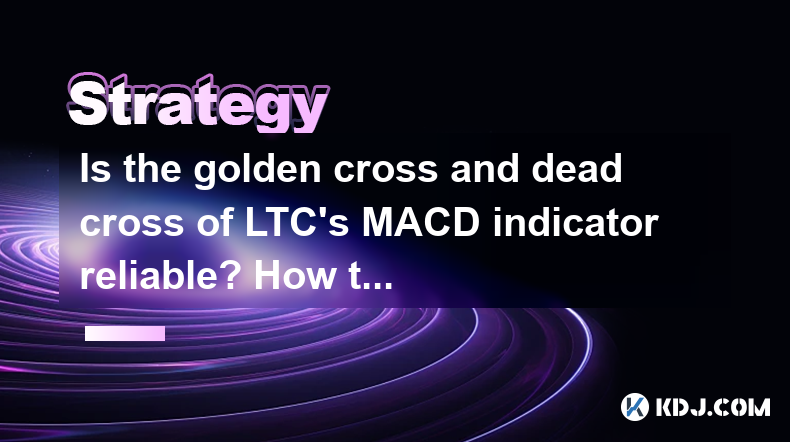-
 bitcoin
bitcoin $121833.232455 USD
-0.63% -
 ethereum
ethereum $4394.437030 USD
-2.00% -
 tether
tether $1.000570 USD
0.04% -
 bnb
bnb $1255.553465 USD
-3.73% -
 xrp
xrp $2.814944 USD
-1.59% -
 solana
solana $221.835346 USD
-2.40% -
 usd-coin
usd-coin $0.999869 USD
0.01% -
 dogecoin
dogecoin $0.249495 USD
-1.32% -
 tron
tron $0.336905 USD
-1.24% -
 cardano
cardano $0.816464 USD
-1.69% -
 chainlink
chainlink $22.130946 USD
-1.27% -
 hyperliquid
hyperliquid $44.208522 USD
-3.46% -
 ethena-usde
ethena-usde $1.000521 USD
0.02% -
 sui
sui $3.422897 USD
-2.51% -
 stellar
stellar $0.380164 USD
-1.31%
Is the golden cross and dead cross of LTC's MACD indicator reliable? How to combine other indicators?
The MACD's golden and dead crosses can signal trend changes for LTC, but combining them with RSI, Bollinger Bands, and moving averages enhances trading reliability.
May 04, 2025 at 04:22 am

The Moving Average Convergence Divergence (MACD) indicator is a popular tool used by traders to identify potential trend changes and momentum in the cryptocurrency market, including Litecoin (LTC). The golden cross and dead cross are specific signals within the MACD that traders watch closely. This article will explore the reliability of these signals for LTC and discuss how to combine the MACD with other indicators for more effective trading strategies.
Understanding the MACD Indicator
The MACD is composed of two lines: the MACD line and the signal line. The MACD line is calculated by subtracting the 26-period Exponential Moving Average (EMA) from the 12-period EMA. The signal line is a 9-period EMA of the MACD line. The golden cross occurs when the MACD line crosses above the signal line, indicating potential bullish momentum. Conversely, the dead cross happens when the MACD line crosses below the signal line, suggesting bearish momentum.
Reliability of Golden Cross and Dead Cross for LTC
The reliability of the golden cross and dead cross signals for LTC can vary based on market conditions and the timeframe used. In highly volatile markets, these signals may generate more false positives, leading to less reliable outcomes. In more stable markets, these signals tend to be more reliable as they can better reflect the underlying trend.
Historical data analysis shows that the golden cross and dead cross signals have had mixed success with LTC. For instance, during periods of significant bullish trends, the golden cross has often preceded price increases, while the dead cross has signaled the start of bearish trends. However, there have been instances where these signals have failed to predict price movements accurately, especially during periods of high volatility or market manipulation.
Combining MACD with Other Indicators
To enhance the reliability of trading signals, it is beneficial to combine the MACD with other technical indicators. Here are some effective combinations:
1. MACD and Relative Strength Index (RSI)
The RSI is a momentum oscillator that measures the speed and change of price movements. It ranges from 0 to 100 and is typically used to identify overbought or oversold conditions. When the MACD shows a golden cross and the RSI is below 70, it can be a strong buy signal. Conversely, if the MACD shows a dead cross and the RSI is above 30, it can be a strong sell signal.
2. MACD and Bollinger Bands
Bollinger Bands consist of a middle band being an N-period simple moving average (SMA), an upper band at K times an N-period standard deviation above the middle band, and a lower band at K times an N-period standard deviation below the middle band. When the MACD shows a golden cross and the price is near the lower Bollinger Band, it may indicate a potential reversal to the upside. If the MACD shows a dead cross and the price is near the upper Bollinger Band, it may suggest a potential reversal to the downside.
3. MACD and Moving Averages
Combining the MACD with moving averages can help confirm trends. When the MACD shows a golden cross and the price is above a long-term moving average (e.g., 200-day SMA), it can reinforce a bullish signal. If the MACD shows a dead cross and the price is below a long-term moving average, it can reinforce a bearish signal.
Practical Application of MACD and Other Indicators
To apply these combinations effectively, traders should follow a systematic approach. Here is a step-by-step guide on how to use the MACD in conjunction with other indicators:
- Identify the MACD Signal: Monitor the MACD line and signal line for golden and dead crosses.
- Confirm with RSI: Check the RSI to see if it supports the MACD signal. A golden cross with an RSI below 70 can be a strong buy signal, while a dead cross with an RSI above 30 can be a strong sell signal.
- Check Bollinger Bands: Look at the price position relative to the Bollinger Bands. A golden cross near the lower band can indicate a potential upward reversal, while a dead cross near the upper band can suggest a potential downward reversal.
- Verify with Moving Averages: Confirm the MACD signal with the price's position relative to long-term moving averages. A golden cross above a 200-day SMA can reinforce a bullish signal, while a dead cross below a 200-day SMA can reinforce a bearish signal.
- Execute the Trade: Based on the combined signals, decide whether to enter a long or short position.
Case Study: LTC Trading with MACD and Other Indicators
To illustrate the practical application of these indicators, let's consider a hypothetical scenario with LTC. Suppose the MACD shows a golden cross, the RSI is at 65, the price is near the lower Bollinger Band, and the price is above the 200-day SMA. This combination of signals suggests a strong bullish case for LTC. A trader might decide to enter a long position based on these indicators.
In another scenario, if the MACD shows a dead cross, the RSI is at 35, the price is near the upper Bollinger Band, and the price is below the 200-day SMA, this combination of signals suggests a strong bearish case for LTC. A trader might decide to enter a short position based on these indicators.
Frequently Asked Questions
Q: Can the MACD be used effectively on shorter timeframes for LTC trading?A: Yes, the MACD can be used on shorter timeframes like 1-hour or 4-hour charts for LTC trading. However, the reliability of the signals may decrease due to increased volatility. It's crucial to combine the MACD with other indicators and use proper risk management strategies.
Q: How often should I check the MACD and other indicators for LTC trading?A: The frequency of checking the MACD and other indicators depends on your trading style. For day traders, checking every few hours or even more frequently may be necessary. For swing traders, checking daily or weekly might be sufficient. Always ensure you are not overtrading based on short-term fluctuations.
Q: Are there any specific settings for the MACD that work best for LTC?A: The standard settings for the MACD (12, 26, 9) are commonly used and can be effective for LTC. However, some traders may adjust these settings based on their trading strategy and the specific market conditions. Experimenting with different settings can help find what works best for your trading approach.
Q: Can the MACD be used alone for LTC trading, or is it always necessary to combine it with other indicators?A: While the MACD can be used alone, it is generally more effective when combined with other indicators. Using the MACD in isolation can lead to false signals, especially in volatile markets. Combining it with indicators like RSI, Bollinger Bands, and moving averages can provide a more comprehensive view of the market and increase the reliability of trading signals.
Disclaimer:info@kdj.com
The information provided is not trading advice. kdj.com does not assume any responsibility for any investments made based on the information provided in this article. Cryptocurrencies are highly volatile and it is highly recommended that you invest with caution after thorough research!
If you believe that the content used on this website infringes your copyright, please contact us immediately (info@kdj.com) and we will delete it promptly.
- Meme Coins, ETFs, and Crypto Regulations: Navigating the Wild West of Digital Finance
- 2025-10-10 10:25:15
- HYPE, PENGU, and BlockDAG: Decoding Crypto's Latest Moves
- 2025-10-10 10:25:15
- Robinhood, Zora, and the Web3 Creator Revolution: A New York Minute on Tokenized Futures
- 2025-10-10 10:30:01
- Trump, Super Bowl, and Halftime: A Wild 2025 Ride
- 2025-10-10 10:30:01
- Cardano, XRP, and DeFi Integration: A Bombshell Development?
- 2025-10-10 08:25:17
- VeChain's Market Cap Dip: Can VET Stage a Recovery?
- 2025-10-10 10:30:01
Related knowledge

Practical parameter settings for a Bitcoin multi-timeframe moving average system
Sep 18,2025 at 10:54pm
Optimizing Timeframe Combinations for Bitcoin Trading1. Selecting appropriate timeframes is crucial when building a multi-timeframe moving average sys...

How can I filter out false breakouts in Dogecoin high-frequency trading?
Sep 22,2025 at 01:00am
Understanding False Breakouts in Dogecoin Trading1. A false breakout occurs when Dogecoin's price appears to move beyond a defined support or resistan...

Techniques for identifying tops and bottoms in the Bitcoin on-chain NVT model
Sep 20,2025 at 07:54pm
Understanding the NVT Model in Bitcoin Analysis1. The Network Value to Transactions (NVT) ratio is often described as the 'P/E ratio' of the cryptocur...

What does the surge in open interest in Bitcoincoin futures mean?
Sep 20,2025 at 11:18pm
Understanding the Surge in Dogecoin Futures Open Interest1. A surge in open interest within Dogecoin futures indicates a growing number of active cont...

How can I use the Ethereum USDT premium to gauge market sentiment?
Sep 18,2025 at 11:55pm
Understanding the Ethereum USDT Premium1. The Ethereum USDT premium refers to the price difference between USDT (Tether) traded on Ethereum-based plat...

What should I do if Ethereum staking yields decline?
Sep 20,2025 at 06:18am
Understanding the Causes Behind Declining Ethereum Staking Yields1. The Ethereum network transitioned to a proof-of-stake consensus mechanism with the...

Practical parameter settings for a Bitcoin multi-timeframe moving average system
Sep 18,2025 at 10:54pm
Optimizing Timeframe Combinations for Bitcoin Trading1. Selecting appropriate timeframes is crucial when building a multi-timeframe moving average sys...

How can I filter out false breakouts in Dogecoin high-frequency trading?
Sep 22,2025 at 01:00am
Understanding False Breakouts in Dogecoin Trading1. A false breakout occurs when Dogecoin's price appears to move beyond a defined support or resistan...

Techniques for identifying tops and bottoms in the Bitcoin on-chain NVT model
Sep 20,2025 at 07:54pm
Understanding the NVT Model in Bitcoin Analysis1. The Network Value to Transactions (NVT) ratio is often described as the 'P/E ratio' of the cryptocur...

What does the surge in open interest in Bitcoincoin futures mean?
Sep 20,2025 at 11:18pm
Understanding the Surge in Dogecoin Futures Open Interest1. A surge in open interest within Dogecoin futures indicates a growing number of active cont...

How can I use the Ethereum USDT premium to gauge market sentiment?
Sep 18,2025 at 11:55pm
Understanding the Ethereum USDT Premium1. The Ethereum USDT premium refers to the price difference between USDT (Tether) traded on Ethereum-based plat...

What should I do if Ethereum staking yields decline?
Sep 20,2025 at 06:18am
Understanding the Causes Behind Declining Ethereum Staking Yields1. The Ethereum network transitioned to a proof-of-stake consensus mechanism with the...
See all articles

























![Web3 Crypto Market Morning Report: Fomo on the Bnb chain continues, Binance launches the chain-sweeping platform Meme Rush, the market value of Xiuxian exceeds 40 million U.S. dollars, OK Binance business war begins [Vic TALK Issue 1437] Web3 Crypto Market Morning Report: Fomo on the Bnb chain continues, Binance launches the chain-sweeping platform Meme Rush, the market value of Xiuxian exceeds 40 million U.S. dollars, OK Binance business war begins [Vic TALK Issue 1437]](/uploads/2025/10/10/cryptocurrencies-news/videos/web-crypto-market-morning-report-fomo-bnb-chain-continues-binance-launches-chainsweeping-platform-meme-rush-market-xiuxian-exceeds-dollars-binance-business-war-vic-talk-issue/68e861c5dbd1c_image_500_375.webp)
















































